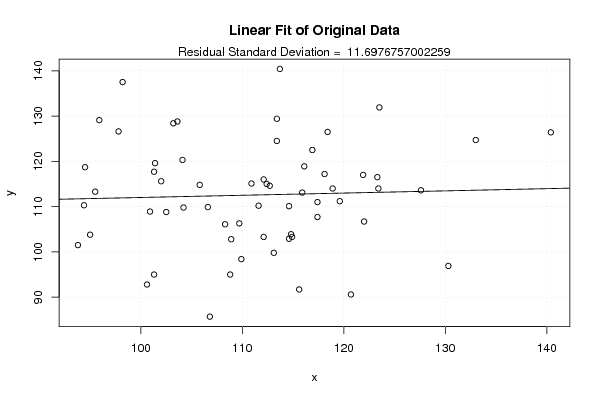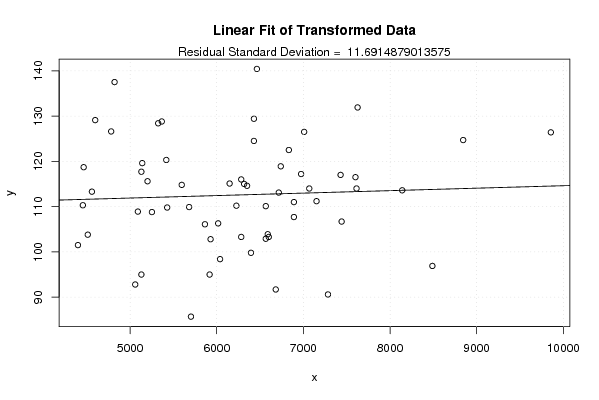Free Statistics
of Irreproducible Research!
Description of Statistical Computation | |||||||||||||||||||||||||||||||||||||||||||||
|---|---|---|---|---|---|---|---|---|---|---|---|---|---|---|---|---|---|---|---|---|---|---|---|---|---|---|---|---|---|---|---|---|---|---|---|---|---|---|---|---|---|---|---|---|---|
| Author's title | |||||||||||||||||||||||||||||||||||||||||||||
| Author | *The author of this computation has been verified* | ||||||||||||||||||||||||||||||||||||||||||||
| R Software Module | rwasp_boxcoxlin.wasp | ||||||||||||||||||||||||||||||||||||||||||||
| Title produced by software | Box-Cox Linearity Plot | ||||||||||||||||||||||||||||||||||||||||||||
| Date of computation | Sun, 09 Nov 2008 05:31:54 -0700 | ||||||||||||||||||||||||||||||||||||||||||||
| Cite this page as follows | Statistical Computations at FreeStatistics.org, Office for Research Development and Education, URL https://freestatistics.org/blog/index.php?v=date/2008/Nov/09/t1226233979vwufwc2crfjo9m8.htm/, Retrieved Tue, 30 Dec 2025 06:57:58 +0000 | ||||||||||||||||||||||||||||||||||||||||||||
| Statistical Computations at FreeStatistics.org, Office for Research Development and Education, URL https://freestatistics.org/blog/index.php?pk=22724, Retrieved Tue, 30 Dec 2025 06:57:58 +0000 | |||||||||||||||||||||||||||||||||||||||||||||
| QR Codes: | |||||||||||||||||||||||||||||||||||||||||||||
|
| |||||||||||||||||||||||||||||||||||||||||||||
| Original text written by user: | |||||||||||||||||||||||||||||||||||||||||||||
| IsPrivate? | No (this computation is public) | ||||||||||||||||||||||||||||||||||||||||||||
| User-defined keywords | |||||||||||||||||||||||||||||||||||||||||||||
| Estimated Impact | 446 | ||||||||||||||||||||||||||||||||||||||||||||
Tree of Dependent Computations | |||||||||||||||||||||||||||||||||||||||||||||
| Family? (F = Feedback message, R = changed R code, M = changed R Module, P = changed Parameters, D = changed Data) | |||||||||||||||||||||||||||||||||||||||||||||
| F [Partial Correlation] [Partial correlation] [2008-11-08 12:17:14] [82d201ca7b4e7cd2c6f885d29b5b6937] F RM D [Box-Cox Linearity Plot] [Box Cox Linearity...] [2008-11-09 12:31:54] [00a0a665d7a07edd2e460056b0c0c354] [Current] - RMPD [Maximum-likelihood Fitting - Normal Distribution] [Maximum-likelihoo...] [2008-11-09 12:55:12] [82d201ca7b4e7cd2c6f885d29b5b6937] F D [Maximum-likelihood Fitting - Normal Distribution] [Maximum-likelihoo...] [2008-11-09 12:58:19] [82d201ca7b4e7cd2c6f885d29b5b6937] F [Maximum-likelihood Fitting - Normal Distribution] [maximum likelihoo...] [2008-11-10 22:36:30] [8d78428855b119373cac369316c08983] - RMPD [Testing Mean with known Variance - Critical Value] [critical value] [2008-11-11 00:28:19] [8d78428855b119373cac369316c08983] F RMPD [Testing Mean with known Variance - p-value] [p-value] [2008-11-11 00:48:00] [8d78428855b119373cac369316c08983] - RMPD [Testing Mean with known Variance - Type II Error] [type 2 error] [2008-11-11 01:19:31] [8d78428855b119373cac369316c08983] - RMPD [Testing Mean with known Variance - Sample Size] [sample size] [2008-11-11 01:44:50] [8d78428855b119373cac369316c08983] F RMPD [Testing Population Mean with known Variance - Confidence Interval] [confidence interval] [2008-11-11 01:58:15] [8d78428855b119373cac369316c08983] F RMPD [Testing Sample Mean with known Variance - Confidence Interval] [confidence interval] [2008-11-11 02:12:01] [8d78428855b119373cac369316c08983] - D [Maximum-likelihood Fitting - Normal Distribution] [Maximum-likelihoo...] [2008-12-10 19:20:50] [82d201ca7b4e7cd2c6f885d29b5b6937] F [Box-Cox Linearity Plot] [Box-Cox] [2008-11-10 22:18:08] [8d78428855b119373cac369316c08983] | |||||||||||||||||||||||||||||||||||||||||||||
| Feedback Forum | |||||||||||||||||||||||||||||||||||||||||||||
Post a new message | |||||||||||||||||||||||||||||||||||||||||||||
Dataset | |||||||||||||||||||||||||||||||||||||||||||||
| Dataseries X: | |||||||||||||||||||||||||||||||||||||||||||||
116,1 102,5 102,0 101,3 100,6 100,9 104,2 108,3 108,9 109,9 106,8 112,7 113,4 101,3 97,8 95,0 93,8 94,5 101,4 105,8 106,6 109,7 108,8 113,4 113,7 103,6 98,2 95,5 94,4 95,9 103,2 104,1 127,6 130,3 133,0 140,4 123,5 116,9 115,9 113,1 112,1 112,4 118,9 117,4 115,6 120,7 114,9 122,0 119,6 114,6 118,4 110,9 111,6 114,6 112,1 117,4 114,8 123,4 118,1 121,9 123,3 | |||||||||||||||||||||||||||||||||||||||||||||
| Dataseries Y: | |||||||||||||||||||||||||||||||||||||||||||||
118,9 108,8 115,6 95,0 92,8 108,9 109,8 106,1 102,8 98,4 85,7 114,6 129,4 117,7 126,6 103,8 101,5 118,7 119,6 114,8 109,9 106,3 95,0 124,5 140,4 128,8 137,5 113,3 110,3 129,1 128,4 120,3 113,6 96,9 124,7 126,4 131,9 122,5 113,1 99,8 116,0 115,0 114,0 111,0 91,7 90,6 103,3 106,7 111,2 102,9 126,5 115,1 110,2 110,1 103,3 107,7 103,9 114,0 117,2 117,0 116,5 | |||||||||||||||||||||||||||||||||||||||||||||
Tables (Output of Computation) | |||||||||||||||||||||||||||||||||||||||||||||
| |||||||||||||||||||||||||||||||||||||||||||||
Figures (Output of Computation) | |||||||||||||||||||||||||||||||||||||||||||||
Input Parameters & R Code | |||||||||||||||||||||||||||||||||||||||||||||
| Parameters (Session): | |||||||||||||||||||||||||||||||||||||||||||||
| Parameters (R input): | |||||||||||||||||||||||||||||||||||||||||||||
| R code (references can be found in the software module): | |||||||||||||||||||||||||||||||||||||||||||||
n <- length(x) | |||||||||||||||||||||||||||||||||||||||||||||

















